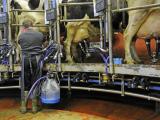Jul 6, 2004 (CIDRAP News) The launching of separate national research centers for food security and foreign animal diseases was hailed by Homeland Security Secretary Tom Ridge and Agriculture Secretary Ann Veneman in a ceremony at the University of Minnesota in Minneapolis today.
Ridge and Veneman came to Minneapolis to herald the establishment of the National Center for Food Protection and Defense, based at the University of Minnesota, and the National Center for Foreign Animal and Zoonotic Disease Defense, based at Texas A&M University.
The Department of Homeland Security (DHS) plans to provide $15 million to the food protection center and $18 million to the animal disease center over the next 3 years. The grants were first announced in late April.
Ridge and Veneman described the grants as part of a comprehensive national strategy to strengthen the nation's defenses against terrorism. The launching "is one more example of a national coordinated effort integrating public, private, and academic sectors," said Ridge. "It's one more signal to the world of our resolve to defeat terrorism and become smarter, more sophisticated, and safer every day."
The two centers join another Homeland Security "Center of Excellence" already in operation: the Center for Risk and Economic Analysis of Terrorism Events at the University of Southern California.
Ridge used the occasion to announce plans for a fourth DHS center of excellence. DHS is inviting applications for funding of a new center that "will focus on the behavioral and social aspects of terrorism and counterterrorism," he said. "It will study both the behavior of terrorists, as well as the social effects of terrorist threats and attacks on our population." He offered no details on the level of funding or timeline.
Veneman and Ridge addressed a crowd of dignitaries and reporters at the university's McNamara Alumni Center. Ridge called the food security centerwhich involves three other universities as well as state agencies, food companies, professional organizations, and individual researchers at still other universities"the heart and soul of our efforts to protect America's food supply."
"Researchers here will partner with industry leaders to establish best practices to manage and respond to food contaminationswhether they are intentional or naturally occurring," he said.
He said he and other federal officials had just been shown examples of some of the research projects that the new center will support. One was a portable device, for use by laboratories and first responders, that could potentially detect up to 96 food contaminants. Other projects include two computer systems for simulating attacks on the food supply and testing responses to them.
In discussing the animal disease center, Ridge said, "The Aggies will work closely with others in academia, industry, and government to address potential health risks such as foot-and-mouth disease and avian flu." In researching food-and-mouth disease, Texas A&M will collaborate with DHS's Plum Island Animal Disease Center, according to a DHS fact sheet.
Ridge asserted that all sectors of society must cooperate to boost the nation's security. "It's important to continue to note that homeland security is more than just a federal department with 180,000 employees. Ultimately homeland security is about the integration of an entire nation," he said.
Veneman talked about the Bush administration's overall efforts to improve food and agricultural security. She said President Bush signed a directive last January that sets forth a national strategy for food and agriculture, which includes the three centers of excellence launched so far.
"The administration has supported record funding levels for safeguarding animal and plant health and food safety," she said. "The president's budget for fiscal year 2005 includes $381 million for new food and agricultural defense initiatives as well as $60 million for BSE [bovine spongiform encephalopathy] or mad cow disease."
Veneman said the US Department of Agriculture (USDA) is increasing its research in security-related areas, including new vaccines and rapid diagnostic tests for a variety of animal diseases. The department's Animal and Plant Health Inspection Service has "set up a state-of-the-art emergency operations center in Riverdale, Maryland," she added.
Veneman also said, "We're in the process of establishing a national food and agricultural organization sector council . . . to expedite the communication of threat intelligence with key individuals in the private sector."
She used her talk as the occasion to announce that USDA is committing $100 million for emergency response services and equipment in rural areas. Under the plan, $1 of every $5 of fiscal 2004 funds for community facilities will be dedicated to emergency response services, according to a USDA news release.
A DHS fact sheet listed a number of other DHS and USDA initiatives related to food and agricultural biosecurity. Among them is "the National Consumer Complaint Monitoring System, a surveillance and sentinel system that monitors and tracks food-related consumer complaints 24/7 and serves as a real-time, early warning system of a potential attack on the food supply."
See also:
July 6 USDA news release dealing with the food protection and animal disease centers and other issues (see last three paragraphs)
http://www.usda.gov/Newsroom/0276.04.html
Apr 27, 2004, CIDRAP News story on the original announcement of funding for the food protection and foreign animal disease centers



















